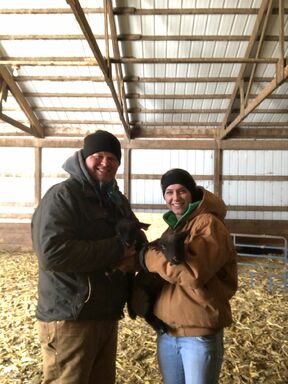Busy calving and lambing seasons pay off with healthy animals
Posted: 3/8/2019
Newborn calves and lambs are an iconic sign of spring, but it takes planning, care and work all year long to ensure those young animals are healthy and ready to enjoy the green pastures of spring and summer.
 D.J. Buseman and his family raise cattle, sheep and crops on their farm near Canistota, South Dakota, and are especially busy from mid-January through March during calving and lambing season.
D.J. Buseman and his family raise cattle, sheep and crops on their farm near Canistota, South Dakota, and are especially busy from mid-January through March during calving and lambing season.
“On the most hectic days, we may have 30 lambs or 20 to 30 calves born,” he said. “Our goal is to keep them warm and dry to give them a healthy start.”
D.J. grew up on the farm and came back to join the operation full-time after college graduation. He farms with his father, Joe Buseman. His mom, Kim, is a kindergarten teacher in Marion, South Dakota. D.J.’s wife, Danya, is the agronomy training coordinator for Hefty Seed Company and also helps with the farm when she can.
Like most farms, the Busemans have evolved their business over the years. They now focus on raising beef cattle. Of the several calves born from their cow herd each spring, the Busemans raise about 90 Angus bulls to be sold to other farmers and ranchers. The remaining calves are typically raised to about 700 pounds and sold as feeder calves.
They raise corn, soybeans, alfalfa and oats and have started planting cover crops that can be used for grazing in late summer and fall. They have also expanded their sheep flock in recent years.
“Both my grandparents had sheep and we had a small flock at our farm when we were growing up and my sisters and I showed them for 4-H,” he said. “When I graduated from college and returned home, I took over the flock and began keeping replacement ewes and occasionally buying additional ewes.”
They now have a flock of 160 Hampshire Suffolk cross ewes. 
“Raising sheep is a great sideline whether you have cattle or are strictly crop farming,” he said. “Sheep really don’t take much labor with the exception of lambing season, and your return on investment may be higher than other livestock right now.”
For the Busemans, calving and lambing season begin with beef heifers (animals having their first calf) in mid-January, then sheep in February and the remaining beef cows in March.
All animals are watched carefully the first several days to make sure they are nursing and healthy. Lambs stay inside a heated lambing barn for about the first four days, then are moved to another barn depending on their health and the weather conditions.
“We keep a close watch on all the livestock as they grow and as the seasons change. The health of the livestock is the most important factor we deal with,” said D.J. “We give vaccinations as the livestock get older to prevent sickness that could occur as they grow. We always make sure the livestock have a balanced diet and we supplement mineral.”
Ensuring that young animals are protected from extreme temperatures and winds is a top priority, and the Busemans use a combination of barns and shelter to make sure calves stay warm and dry until the weather cooperates and they are strong enough to be outdoors.
For D.J., the hard work and long hours of calving and lambing season pays off as the animals grow.
“The most rewarding part of raising livestock is seeing the babies grow and change over the course of the year,” he said. “You work hard to get them up and going in the cold, then get to see the progress through the green grass of the summer.”
 Because the Busemans sell both bulls and bucks (male sheep) to other farmers for breeding in their own herds and flocks, they also get feedback on how those animals perform
Because the Busemans sell both bulls and bucks (male sheep) to other farmers for breeding in their own herds and flocks, they also get feedback on how those animals perform
“When customers call and tell us how happy they are with the calves out of our bulls, or how well their lambs grew out of my bucks, it makes it even more worth it,” he said.
Continuing the family tradition of farming is important to D.J. He lives on the farm where his grandparents live and his dad grew up, and now has the opportunity to work with his father every day.
“A rewarding part about farming is working outside and alongside my dad on the farm that he has worked to keep going his entire life,” said D.J. “There will always be challenges in farming and ranching. I think it is important to eliminate risk where you can, and have faith that the Lord takes care of you in situations that are out of your control.”

Comments
blog comments powered by Disqus